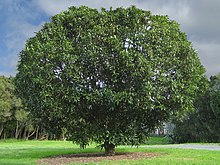Nestegis
| Nestegis | |
|---|---|
 |
|
| Black maire (Nestegis cunninghamii) in New Zealand | |
| Scientific classification | |
| Kingdom: | Plantae |
| (unranked): | Angiosperms |
| (unranked): | Eudicots |
| (unranked): | Asterids |
| Order: | Lamiales |
| Family: | Oleaceae |
| Tribe: | Oleeae |
| Genus: |
Nestegis Raf. |
| Synonyms | |
|
Gymnelaea (Endl.) Spach |
|
Gymnelaea (Endl.) Spach
Nestegis is a genus of flowering plant in the olive family, Oleaceae. There are five currently accepted species in the genus: three species are endemic to New Zealand, while one can be found on New Zealand and Norfolk Island. Another is restricted to Hawaiʻi.
The related genus Osmanthus is sometimes included here.
The name Nestegis is of unknown origin, since the author Constantine Eugene Rafinesque often invented generic names from scratch. It may have no meaning at all or it may derive from Greek stegos (στέγος) meaning "cover" in allusion to the lack of a corolla in the type species, Nestegis apetala.
Nestegis species are evergreen trees or shrubs. The leaves are opposite, simple, entire, and coriaceous. The inflorescence is axillary, decussate, sometimes terminal and somewhat paniculate. The flowers are either bisexual or functionally unisexual. The corolla is either absent or four-lobed with a short tube. There are two or four stamens. The ovary is shaped like a flask. The fruit is a drupe containing a single seed.
...
Wikipedia
